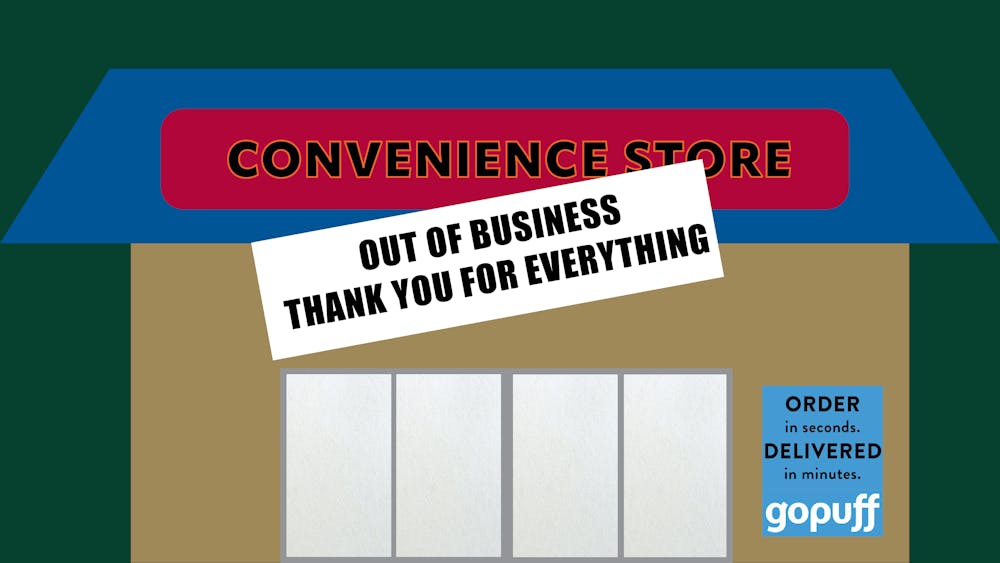One month ago, I had never used Gopuff, despite being tech–savvy and usually in–the–know.
I tried some similar apps in the past like Instacart, Postmates, DoorDash, and UberEats—each served its purpose. I started using Instacart during COVID while working as an RA on campus and was too afraid to go to the grocery store myself. I’ve since used DoorDash, UberEats, and other delivery services when I’ve wanted food but have been too lazy to go out and get it myself.
While delivery sites were great for making sure I didn't need to get up, they often faced the same problem: they could only deliver something from a certain store during the store’s operating hours. So, if I ever needed an item late at night, I’d be out of luck.
But Gopuff seems to tackle this conundrum head–on. Unlike other delivery services that just pick up food and bring it to your door, Gopuff has its own warehouses where it sources its items. It offers extensive goods, ranging from Tylenol to fresh produce.
The app was founded by Rafael Ilishayev and Yakir Gola in 2013. The duo started the company in Philadelphia while being full–time students at Drexel University. Initially, their goal wasn’t to compete with larger delivery apps like Postmates and DoorDash. Instead, in an interview with Entrepreneur, Gola claimed, “The concept of the convenience store is [Gopuff’s] chief competitor.”
If Gopuff does see convenience stores as its competitor, it raises questions about how their operations could negatively impact local corner stores. Already, in–person convenience stores and corner stores struggle in an increasingly technological age. According to the 2022 NACS/NielsenIQ Convenience Industry Store Count, the number of convenience stores in the U.S. has dropped for its fourth consecutive year, this time by 1.5%. While the increasingly digital age might seem harmless, the loss of locally owned convenience stores to large corporations may negatively impact worker’s rights.
Gopuff has recently come under fire for worker mistreatment. In 2021, Gopuff workers in Philly went on a one–day strike with complaints of low pay and worries about their safety. One worker complained that while the company claims to pay workers $15 to $25 an hour, they don’t cover gas or car repairs, nor do they cover cell phone data costs—all necessary tools for the job. Furthermore, Gopuff's pay decreased further during a period of overhiring and a lack of shift availability.
Part of the problem, too, is that Gopuff workers are treated as independent contractors, meaning that, on paper, the company is not required to pay minimum wage, provide unemployment insurance, or pay for overtime. Although they are considered independent contractors, workers are required to report to managers and even message them on Slack when they stop for gas, leading to an overall lack of independence.
While Gopuff is convenient for consumers with its low delivery fees and costs, it’s not ideal for workers. With low pay and subpar working conditions, Gopuff exacerbates current trends seen with large corporations, such as Amazon, of overworking or mistreating the working class.
Aside from the issue of worker exploitation, the rise of delivery apps like Gopuff raises questions about the fate of the convenience store—will we reach a point where going to the corner store is obsolete?
Personally, I doubt it. Sure, delivery apps are quick and easy to use, and often preferable to walking to grab food and groceries. In the Entrepreneur interview with Gopuff’s founders, they even mentioned that one of their first orders was to a person living in an apartment building right next to a 7–Eleven. Despite the fact that the man could simply walk downstairs and pick up food for himself, he chose to have it delivered.
Despite the convenience, not everybody wants delivery via app. Not only do these services cost more, they can also take much longer. While the Gopuff's “delivery fee” is only $2.95, the company often adds on other fees that amount to almost $5. In addition, a user must meet a minimum order price to actually make a purchase. This means that if you only want a couple of things, you will be encouraged to buy more and spend more just to actually use the app. My first order with GoPuff ended up being nearly $30, despite my original intention of just grabbing a few avocados and chips. Corner stores still work as an easy, quick way to pick up a few necessary items without paying an exorbitant amount.
Most consumers won’t completely abandon convenience stores or Gopuff entirely. For now, the two can coexist in the digital and real world.







